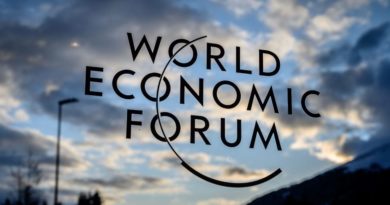QAnon now pushes alarming conspiracy myths targeting China and Jews

Experts on extremism are warning about a troubling shift in the right-wing QAnon movement toward a new vein of conspiracy that blends anti-Chinese and anti-Jewish tropes with fears of vaccines and a global plot to take over the world.
Broadly collected under the idea of a “new world order,” it’s a QAnon rebranding, said researcher Joel Finkelstein, director of Rutgers University’s Network Contagion Research Institute, allowing conspiracy theorists to pivot after a year of political upheaval, scrutiny and disappointing predictions.
It marks a shift from the wild lies the movement spread before the election and in subsequent efforts to keep former President Donald Trump in office, even after he lost to Joe Biden. Finkelstein and others said the switch, and the emphasis on suspicion toward Asians and Jews, could lead to more violence.
“That is what I worry about,” said Cynthia Miller-Idriss, a professor at American University in Washington, D.C., who runs the Polarization and Extremism Research & Innovation Lab. “Individuals who are either unstable or have been really radicalized during a long pandemic.”
At the start of the virus shutdowns, said Finkelstein, much of the racially charged conspiracy dialogue centered around the virus originating in China and included “disgust” toward Asians, with leaders including Trump insisting on labeling it as the “kung flu” or “Chinese flu.”
Since the election, the anti-Asian sentiment has shifted to anxiety about worldwide dominance, specifically a communist overthrow of governments backed by Jewish people who control wealth. President Biden is seen as a pawn of these elites.
“The latest round seems to be motivated by the political dominance stuff,” Finkelstein said. “There is a huge component of this that China is taking over.”
More broadly, extremist specialists say QAnon is seeking to maintain relevance by swallowing other conspiracy movements.
“They are unifying under a giant umbrella of a common enemy. Sometimes it’s the Jews. Occasionally it’s the Asians, usually it’s the government,” Finkelstein said. “What is happening is they are fishing for different issues to cause violence with.”
Following the November election, Finkelstein, Miller-Idriss and other extremism trackers noticed a shift in memes and codes words used by conspiracy peddlers. They appeared to be seizing upon a decades-old fear that tumultuous events in people’s lives — such as the pandemic and its subsequent lockdowns — are part of a master plan to subjugate the masses and replace legal norms with the totalitarian rule of a select few.
Those who study extremism said the transition by QAnon story peddlers is expected, but also signals that lies, racism and propaganda in American politics will continue to have staying power.
It is a “large tent of distrust of government and authority” that allows for “a variety of followers who oftentimes have general fears and grievances but not necessarily more specific types of commonalities,” said Brian Levin, professor of criminal justice and director of the Center for the Study of Hate & Extremism at Cal State San Bernardino.
“It really creates an attractive opportunity for extremists to ensconce themselves into divisive, emotionally charged issues where they can focus on the grievances and the villain and not necessarily their own baggage,” Levin said. “QAnon is like a newt’s tail. It can constantly reconstitute itself.”
The QAnon reboot is “new words for old terms that have existed for quite a long time,” said Jason Blazakis, professor at the Middlebury Institute of International Studies and director of its Center on Terrorism, Extremism and Counterterrorism.
Globalist paranoia dates back to the 1960s and is built upon anti-Semitic ideas that go back centuries. The web of conspiracies gained popularity in the 1990s after then-President George H.W. Bush used “new world order” in a speech about the fall of Soviet communism, fueling anxiety about government overreach, a loss of liberty and gun rights. Where once conspiracy theorists looked to Russia as the enemy, they were suddenly left without a malefactor. They filled that void with an evil global cabal, Levin said.
Those fears of dark forces acting just out of sight were recycled in QAnon conspiracies from its start in 2017, when an anonymous poster known as Q began offering cryptic messages about secretive government operatives working against Trump. But QAnon quickly spun into the specific and fantastical, with the new world order ideas pushed to its outskirts.
Levin said conspiratorial politics are growing not just at the national level, but in state and local issues as well. Finkelstein’s group recently found that Southern California is “the hottest of hot spots,” when it comes to such conspiracy.
In late January, when protesters shut down the vaccine site at Dodger Stadium, his research team tracked a surge in online new world order activity, including posts tagged with #greatreset, #scamdemic and #agenda21, a theory based on a 1990s United Nations resolution that some consider proof of a plot to depopulate the Earth.
The reasons why some Southern Californians have latched onto new world order rhetoric are complex. Finkelstein’s organization found a correlation between places with high incidence of both Black Lives Matter activity and what he terms as pushback against it in the form of anti-mask, anti-lockdown rallies — a mix that fed new world order activity online. Los Angeles County had the greatest abundance of both types of protests, followed by San Diego and Orange counties.
“Where the Black Lives Matter protesters showed up, the quarantine became sort of a counter-cause,” he said. “This idea that ‘we are the ones being victimized.’”
Aside from the Capitol insurrection in January, QAnon believers have been implicated in more than a dozen acts of violence across the United States, and hate crimes against Asian Americans have surged. As virus restrictions ease, the pent-up vitriol of online politics will likely spill elsewhere.
“It’s not just a prospect,” said Miller-Idriss. “It’s a reality.”


